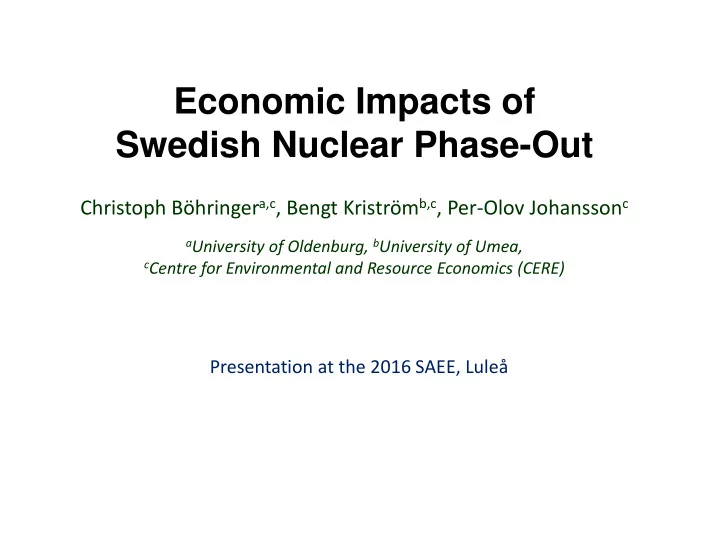

Economic Impacts of Swedish Nuclear Phase-Out Christoph Böhringer a,c , Bengt Kriström b,c , Per-Olov Johansson c Weak and Strong Sustainability Assessment in Fisheries a University of Oldenburg, b University of Umea, c Centre for Environmental and Resource Economics (CERE) Presentation at the 2016 SAEE, Luleå
Policy Background Nuclear power has been controversial since the very beginning: • Nuclear referendum in 1980 after Harrisburg (1979): nuclear phase-out in 2010 • Further nuclear disasters in Chernobyl (1986), Fukushima (2011) Pros and Cons: • Pros: Low-cost energy source (industrial competitiveness) Supply security (oil independence) CO 2 -free energy source (climate change) • Cons: Risk of large-scale accidents Long-term waste storage Proliferation Phase-out policies: • Direct legislation (referendum, parliament vote) • Economic disincentives (security standards, external cost pricing)
Policy Background Breakdown of electricity production by source, 2015 (in %): Source: Eurostat (online data code: nrg_105m) • River protection: Hydro is no large-scale substitute for nuclear power.
Policy Background Electricity prices for industrial consumers, 2015s2 (EUR/kWh) Source: Eurostat (online data code: nrg_pc_205)
Research Value-Added Literature review: • Bergman (1981), Mills (1990), Nordhaus (1995), Andersson&Haden (1996), Nyström&Wene (1999): Impact assessment of 1980 referendum with phase-out in 2010 “The economic and environmental rationale for a nuclear phaseout is very thin.” (Nordhaus 1995) Our contribution: • Update to business-as-usual ( bau ) in 2030 starting from 2011 base year data: EU climate and energy package 2030 (ETS and non-ETS targets) BaU projections on GDP, fuel prices, energy demands, and CO 2 pricing • Comprehensiveness quantitative impact assessment: Price-responsiveness of supply and demand: general equilibrium Structural change and international competitiveness: multi-sector, multi-region Technology foundation: bottom-up representation of Swedish power supply • Caveats: Uncertainty of exogenous bau projections Omission of transitional adjustment cost (lstatic analysis) No treatment of risk (aversion)
Economic Impact Drivers Endowments, technologies, preferences: • Endowments: How does regulation affect the productivity of factors, i.e., factor earnings (e.g. rents on nuclear capacity)? • Technologies: How easy can production adjust to policy constraints? • Preferences: How much does regulation interfere with consumer choices? Direct and indirect impacts: • Direct: Price (MC) Price (MC) demand demand supply supply Nuclear Hydro quantity quantity Coal Gas Wind Hydro Coal Gas Wind Loss in economic surplus due to shift from lower-cost to higher-cost supply option Loss in economic surplus due to increased market price • Indirect: Spillover effects to other markets Economy-wide reallocation of resources
Analytical Framework Computable general equilibrium (CGE): • Comprehensive incorporation of market interactions • Origination and spending of income (income closures) • Calibration of technologies and preferences based on empirical data Generic model structure: RA r^ = Representative agent in region r Y ir = Production of good i in region r L r = Labor in region r C ir = Consumption demand for good i in region r K r = Capital in region r A ir = Armington production of good i M ir = Imports of good i from region r
Data Base-year data (2011) for 140 regions and 57 sectors by GTAP(9): • National input-output tables and bilateral trade flows • Energy flows and CO 2 emissions Business-as-usual data for 2030: • International energy outlook (IEO): GDP, energy demands, international fuel prices • EU commission: CO 2 emission budgets and prices • CERE: electricity generation mix and merit-order Elasticities: • GTAP: trade elasticities, value-added elasticities • Interfuel substitution elasticities: Steinbuks and Narayan (2014) • Fossil fuel supply elasticities:: Graham, Thorpe and Hogan (1999), Krichene (2002)
Regions and Sectors in the Model Regions: Sweden, Rest of the EU (incl. Norway), Rest of the World Sectors: • Energy carriers: crude oil (cru), coal (col), gas (gas), refined oil (oil), electricity (ele) • Energy- and trade-exposed (EITE) industries based on electricity intensity, export intensity, EU-ETS coverage (trade intensity and additional CO 2 cost) v_f Vegetables, fruit, nuts nmm Cement, concrete, plaster tex Textiles ppp Paper products, publishing crp Chemical, rubber, plastic products b_t Beverages and tobacco products omn Other mining ehi Other electricity-intensive sectors (>AVE) AVE average nfm Metals lea Leather products elo Other electricity-extensive sectors (<AVE) i_s Iron&steel lum Wood products eis Other ETS sectors
Phase-Out Scenarios Central case simulations: • Gradual reduction of nuclear power from business-as-usual ( bau ) to − 75% ( NUC75 ) − 50% ( NUC50 ) − 25% ( NUC25 ) − 0% ( NUC0 ) with bau capacity bounds on hydro, gas and coal. Results : • Electricity market (price, output, generation mix, imports) • Impacts for Swedish EITE industries (output) • Macroeconomic adjustment cost (change in real income) Sensitivity analysis on technology options: • Expansion of renewable power: scaling of supply elasticities ( 0.5 ; 1 ; 2 ) • Expansion of fossil fuel-based power generation: yes , no
Electricity Market • Producer prices (PY) – domestic generation (Y_q) – domestic consumption (C_q): • Power generation mix (% share of production) • Filling the nuclear gap (in %):
Electricity- and Export-Intensive Industries • Production (% from bau ) • Export (% from bau )
Economic Welfare • Real income losses (% from bau GDP) GE: CGE model calculation PE: simplistic partial equilibrium calculus of loss in economic surplus due to nuclear phase-out
Sensitivity Analysis • Welfare impacts for total phase-out ( NUC0 ): Renewable supply elasticity ( 1 , 0.5, 2) Fossil fuel expansion ( no , yes) • Filling the nuclear gap (in %) for total phase-out ( NUC0 ): Renewable supply elasticity ( 1 , 0.5, 2) Fossil fuel expansion ( no , yes)
Concluding Remarks • Nuclear phase-out implies non-negligible welfare cost (Caveat: external cost estimates for nuclear risks). • Partial equilibrium estimates of direct cost are a poor proxy for overall economic impacts. • Technology characterization of renewable and fossil-fuel-based power generation is a key driver of economic adjustment (beyond the scope for electricity imports).
Simplistic PE Calculation of Welfare Losses in 2030 (NUC0) All_TWh 197 NUC_TWh 69 Out_bnSEK 139 PP-Öre/KWh 71 NUCrent-Öre/KWh 38 NUCrent-SEK 26 GDP-SEK 3423 Loss%GDP (in %) 0.773
Power Generation in 2030 (in TWh)
Recommend
More recommend